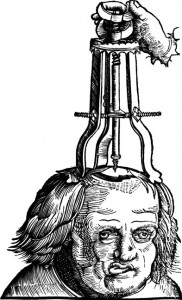Neurosurgery was a brave new world in the 19th century, and the Brooklyn Daily Eagle greeted its dawning with its usual shaky grasp on facts. An excerpt from an article in the October 13, 1895 issue:
“It is only in the late years that surgeons have operated on the brain. They can remove a pistol ball from the brain where, as in some cases, it has lodged without fatal results, and send the patient about his business in less than two weeks’ time. A quarryman by the premature explosion of a blast had a drill driven through his head, piercing his brain through and through. A successful surgical operation was performed upon him.
Some surgical operations on the brain result in increasing the intelligence of the patient. An eminent expert in brain surgery in this country (Dr. Kean of Philadelphia) made a particularly successful operation on an epileptic boy of 16 who in ten years had 5,000 fits. An extraneous growth of nearly an ounce was removed from the right parietal region. Another expert has predicted that in course of time operations of the brain will be performed for the relief of apoplexy and epilepsy, and that such operations will be successful. A few years ago there was a little girl patient in one of the hospitals of Paris. She exhibited an almost utter absence of intelligence. She had a mournful look, lackluster eyes and could not be aroused even to take an interest in dolls. She breathed with difficulty in consequence of the thorax having stopped its development, and her brain had ceased to grow at an early age owing to the premature coalescence of the bones in infancy. The surgeon Lannelongue attributed her unfortunate condition to the narrowness of the cranial box, and believed that if more space were given to the brain her idiocy would disappear and she would attain a normal existence. The operator who had previously experimented on dead children in studying the same trouble made a long and narrow incision in the middle of the skull, and on the left side, which was more depressed than the right, removed a substance of tissue bone nine centimeters long by six millimeters broad. The dura matter, which is in the exterior envelop of the brain, was not touched, and the superficial wound was united by the skin again. Within three weeks after the operation there was a remarkable change in the child; she walked, smiled and became interested in all that was going on around her. An operation exactly parallel to this was performed by an American surgeon in Cincinnati; in this case the child was much younger, but the operation was completely successful.
 Another singular case was that of a housemaid employed in a New York family. She began to show signs of exceptional stupidity; so much that she became unable properly to attend to her duties. One of the first things the girl did was to visit a New York hospital on a friendly call to her sister, who was employed in the institution. The discharged servant had often complained of having severe headaches. A young physician in the hospital, hearing her speak of her trouble, made an examination of her head and found that the bones of her skull had never knitted together. A surgeon operated on her head and succeeded in closing the aperture. Only a few days after the operation the girl became as bright as she had ever been, was taken back by her former employer, where she was soon recognized as one of the most accomplished housemaids.”
Another singular case was that of a housemaid employed in a New York family. She began to show signs of exceptional stupidity; so much that she became unable properly to attend to her duties. One of the first things the girl did was to visit a New York hospital on a friendly call to her sister, who was employed in the institution. The discharged servant had often complained of having severe headaches. A young physician in the hospital, hearing her speak of her trouble, made an examination of her head and found that the bones of her skull had never knitted together. A surgeon operated on her head and succeeded in closing the aperture. Only a few days after the operation the girl became as bright as she had ever been, was taken back by her former employer, where she was soon recognized as one of the most accomplished housemaids.”

